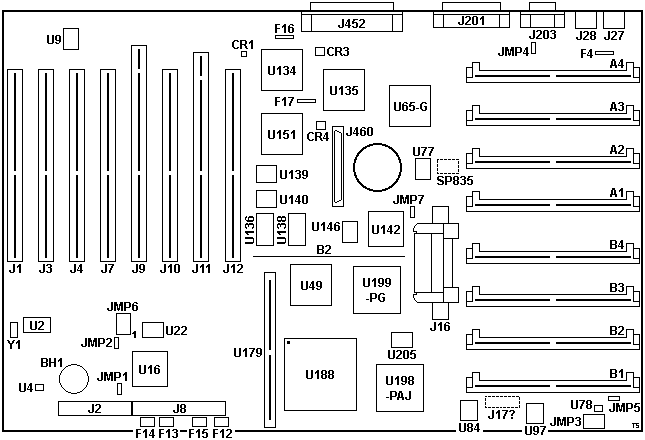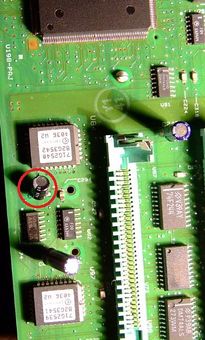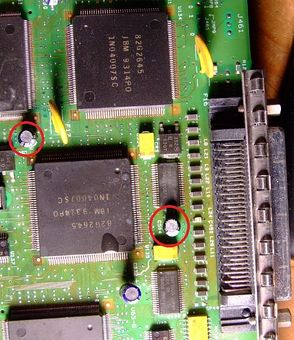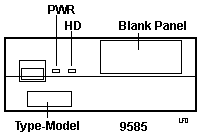|
9585rf.exe Reference Disk v1.32 (zipped image)
9585rd.exe Diagnostics Disk v1.30 (zipped image)
Rev71upd.exe F/W SCSI Adapter Firmware Upgrade 7.1 (zipped image)
193-295 SERVER 85 433 AND 466 - New Models
"F5JW15UK" BIOS Upgrade - If you know where it is, Tell Us!
9585 Power (same form-factor as 95, but 288W)
486 Interposers and Upgrades
Operator Panel Upgrade for 9585 K/N
Odd bracket in Basil's ONT (why is a fan power bracket there, see the plug holder?)
K/N Planar
Leaking Capacitors
95A Ports
95A Operator Panel
Problems Installing OS/2 on 9585 (2.x and Warp)
L2 Cache
K/N Features
ADF sections
K/N Planar DX-33: FRU P/N 61G2405; DX2-33/66: FRU P/N 61G2401, P/N 82G2480, "ELMER V5.0"

U78 Pin 6 of the ST93C46A EEPROM chip is
not grounded, setting it to the 64 word x 16 bits mode. This setting is
reflected by the BIOS code.
JMP6
Remote Maintenance Service Connector
can be used to add a reset button.
Important: Some of the electrolytic capacitors
are prone to leaking! If your board is affected by this problem, you should
replace the capacitors and clean the board as soon as possible. Otherwise, the
leaking electrolyte will inevitably destroy the board! More information
below.
Leaking Capacitors
My planar F/W adapter refused to respond to a Controller Reset in Advanced
Diags. It would not flash to the C9 level of BIOS. What really plugged things
up was a Corvette controller in a slot could not format an HD, because the
planar SCSI had thrown an error and the diags had flagged it.
I stripped the system down and started to blow out the slots and around the
chip leads with computer duster (cheap brand from Staples). It was then that I
noticed the green on some chip leads and on top of the planar. From experience,
it was necessary to pull the planar in order to wash the corrosion off
effectively.
First wash was with white vinegar and that really cleaned things up. The
next wash is with baking soda so we neutralize any acidic compounds still on
the board.
Further investigation showed that ALL three Nichicon 10 uF, 25 V, 105 °C
electrolytic capacitors (N251) had blown.
The three caps were:
C293 under U84
C503 by upper right corner of internal F/W connector.
C504 by U131

C293 on left lower corner
|

C503 and C504 by External SCSI port
|
Of the three, C503 was the most significant because it is to the upper left
of U135. It managed to corrode some pins at the upper left corner, and the PPTC
F17 made it a bit cramped to apply the vinegar.
Tom says:
My board had the very same problem. C293, C503, and C504 leaked
and corroded some nearby vias and parts. Thankfully it didn't case any permanent
damage it seems. Recapped the board, and gave it a good cleanup...
9585-K/N Ports

COM supports up to 345K
LPT is bi-directional parallel
SCSI is a Fast/Wide
9585-K/N Indicator Panel

More information about the indicator panel can be found
HERE.
Reference v 1.31 on the -xXx?
Another word for the BIOS: Once you'd put the inappropriate version of the
Reference / Diags on an 85 and start for example OS/2 ... you could see really
odd effects. Putting the 1.31 code from the -xNx on a -xXx result in a "speed
cursor": a fast flashing icon on PM and you cannot click that fast to do
anything with the machine anymore with using the mouse. You need to shutdown
the beast over the keyboard. The xxx.BIO files differ - and these set the
onboard timers to false base values. I had that in '92 or '93 when customers
complained about inability to use their machines after "an update". They used
the 1.31 "just because it was there and had a higher revision number". Without
thinking and reading the DOCs as it seemed.
Parity / ECC in System Programs
The 85 can emulate ECC using parity SIMMs. This is not worth it. Leave the
Memory Detected setting in Change Configuration to "Parity". Go to
"ECC-P" for more
details.
System memory can be expanded up to 256 MB using 32 MB Parity SIMMs. 2 MB to
32 MB Parity SIMMs are supported, INTERLEAVED ONLY. All 256 MB are addressable
by Direct Memory Access (DMA). SIMMs must be installed in pairs of the same
size. speed, and type. (Ed. I have used 32 MB
EOS SIMMs successfully.
If you do, use the "Parity" setting under System Programs. Remember, the ECC
function is performed on-SIMM so using ECC-P is redundant at best).
Mixed Memory Sizes in K and N Models
When a mixture of 4 MB, 8 MB and 16 MB (or larger) SIMMs are installed in
the 9585-xKx and -xNx computers, install the larger pairs in the lower numbered
connectors (A1/B1 lowest) and the smaller pairs must be installed in the
higher-numbered connectors (A4/B4 highest).
Parallel Port
Bidirectional with DMA support. 100 KB/s max supported speed.
Fast/Wide SCSI
The IBM SCSI-2 Fast/Wide busmaster controller is integrated on the system
board. It uses the same chipset as the Fast/Wide SCSI. 40MB/s Data Streaming to
MCA bus (32 bit), 20 MB/sec on SCSI bus (16 bit).
Server 85 - Sharing External SCSI DASD fails
External SCSI DASD expansion shared between two system fails when one of the
systems is powered down.
On the 9585 0N* the trace on the solder (back) side of the planar running
parallel below resistor R351 must be cut. On the SCSI-2 F/W controller the
trace running next to C30 on the component side of the card must be cut. This
trace runs from the fourth pin from the right on the bottom of the larger IC
next to the external connector.
They did not EC the planar due to the expected low instances of this problem.
Ed. Unless you >actually< share SCSI
devices externally, I wouldn't touch a thing.
50 to 68-pin adapter
A 50-pin cardedge to a female 68-pin half pitch Centronics is FRU61G3594.
The female 68 pin socket is an AMP part.
Can't Use >7 SCSI Devices
From John Poltorak:
How come your machines can always use 15 devices and mine max out
at seven?
From Peter:
Q1: Which internal cable do you have? The odd-colored woven double
wire cable with 50 pin connectors ? Or the "later" internal Wide-SCSI cable
with 68-pin plugs at the device ends?
Q2: (results from Q1:) which port on the internal adapter are you using ?
The 68-pin Molex (black plastic) directly on the board or do you have the
Molex-to-50 card-edge converter in between ? If so - the adapter is switched
into 8-bit narrow mode and will take only 7 devices. You need to use the 68-pin
Molex without the converter to have advantage of the 16-bit Wide mode. If you
have the converter attached to the Molex the external port is also run in 8-bit
mode as far as I know - and limits the adapter to... seven devices.
The planar F/W SCSI on the Server 85 is *similar* to the "3 connector" F/W
SCSI adapter /A (8EFC) - but it differs a lot. The F/W card has a separate
50-pin card-edge connector for the internal devices - and using this connector
with only "narrow" devices does not afflict the ability to use "Wide" devices
on the external port - given that you use a "wide" cable as well. You cannot
use an internal narrow cable and external narrow cable as well and hope that
you can address 15 devices with that. This will not work. As soon as you use an
8-bit cable you are cut to 7 devices on the planar F/W.
Enhanced security
The Server 85 433 and 466 with
LogicLock
and new tamper-evident, locking covers, Privileged Access
Password, selectable drive startup and support for
optional features (such as, the new
Cable
Cover 4 and the Enhanced 2.88MB 3.5-inch Diskette
Drive with electronic eject) provide system security
exceeding C2 enabling requirements.
Remote power-on
feature that allows the server to be powered-on
remotely via an external modem, or from an internal
timer. Remote power-off can be achieved through software
control and is beneficial for running reports or
printouts remotely, during off-shift periods.
Unattended start mode
The Server 85 433 and 466 models can automatically restart
the server after a power failure and resume normal
operation, without operator intervention.
Vital Product Data
(VPD) enabled for unique ID (model/submodel);
Type/model/serial number; Planar serial number;
Manufacturing ID; Planar FRU number; Planar part number.
A system administrator can view from the LAN the PS/2
Server 85 models that reside on the network, including
configuration. This function can also serve as a
security measure by confirming if unauthorized servers
are connected to the network.
Problems Installing OS/2 on 9585 Computer
(HERE)
From Joltin' Joe Kovacs:
One of the following error messages is displayed at
Diskette 1 while installing OS/2 on an IBM PS/2 9585
computer:
- OS/2 Warp: OS/2 is unable to operate your HD or diskette drive.
- OS/2 2.x: The system cannot find the file 'A:\COUNTRY.SYS'.
The diskette-drive light stays on, and pressing
Ctrl+Alt+Del has no effect. The system must be turned off
and then turned back on.
Note: This problem
is particularly troublesome because at the first sign of
trouble during OS/2 installation, users remark-out (REM)
all unneeded drivers in the CONFIG.SYS file; for
example, BASEDEV=IBM1*.ADD. This should be a line of
action because the PS/2 9585 is a Micro Channel system.
However, if the statement BASEDEV=IBM1FLPY.ADD is
remarked-out, OS/2 installation will fail with one of
the above error messages.
Make sure the REM in front of
BASEDEV=IBM1FLPY.ADD is removed in CONFIG.SYS file. If
the line was deleted, restore it. If there are no other
problems, the installation will work.
L2 Cache
0Kx - 128 KB L2 WB cache. 0Nx - 256 KB L2 WB cache.
The 85 K/N uses cache modules with the same form factor and electrical
interface as the Lacuna planar.
However the modules are not typically interchangeable. More information
HERE.
L2 Cache 128 KB (for DX-33) - 61G4098
L2 Cache 256 KB (for DX2-33/66) - 61G4098
Field experience:
I tried a variety of L2 modules in my N. They all
failed (with POD and interposer) until I tried an IDT
256K WB module, 7MP6150. To my surprise, the Cypress OEM
P/N 06H3306 and P/N 06H3307 failed, either jumpered for
WB or WT. The failures were a continuous looping reboot,
or a black screen (with interposer).
K/N Features
- Intel Pentium Overdrive upgradable (socket is 19x19 LIF)
Note: The CPU socket is right behind Bay #3. The
original DX2-66 in my 85 had about 3/8ths of an inch of the heatsink fins
milled off on the left side of the 486. If you use a POD (like me) be cautious
of trying to ram a 5.25" drive or CD into that bay... "It won't fit!
@%#&!!! Bam! Bam! Crunch!" Without the interposer, the POD does not
tolerate any of the L2 cache modules I have, either IDT or Cypress (IBM). I had
to take out the cache. The interposer looks like
THIS. Details how to make your own
are there too.
- SurePath BIOS, upgradeable via Flash EPROM. (IBM never released an upgraded
BIOS. My ONG has BIOS 00.)
- SCSI-2 F/W adapter (Oh yeah baby! Oh, behave!)
- Capable of 256 MB w FPM -OR- EOS (Ed. I have used both 256 MB FPM and
EOS)
ADF Sections AdapterId FEDF
Num Lock
How the Num Lock key is set when the operating system is started.
Please note that your operating system environment might change the setting of
the Num Lock key.
<"Off">, On
Display F1 prompt to access System Programs
During startup, your system normally displays a prompt that tells
you to press F1 for access to the system programs. If you wish to suppress this
prompt, change this to <No>"
<"Yes">, No
Hands-off Configuration
[this is commented out]
Normally, when you add or remove adapters, devices, or memory, you
provide input to reconfigure the system. If you change this setting to
<Enable>, the system will attempt a hands-off configuration when
hardware is added or removed. No user input will be required unless the
default values cannot be used.
< "Disable" >,
Enable
Serial Port
The serial port can be assigned as Serial 1 through 16, or disabled.
Standard COM port interrupt levels are IRQ 4 for serial 1 and IRQ 3 for any other
serial level.
<"SERIAL 1, IRQ 4">,
many choices, Disabled
Parallel Port
The parallel port connector can be set as Parallel 1 through 4 or
the port can be disabled.
<"PARALLEL 1">,
2, 3, 4, Disabled
Parallel Port DMA Arbitration Level
If the level selected is shared then other devices can be set at
the same level. If the level selected is dedicated then only this device
can be set to that level. Select <Disabled> to use the port in
compatibility mode.
<"Shared level 7">,
6, 5, 4, 3, 1, 0, Dedicated 7, 6, 5, 4, 3, 1, 0, Disabled
SCSI Address (ID)
ID of the built-in SCSI controller. Under normal circumstances,
select <7>.
<"7">,
6, 5, 4, 3, 2, 1, 0
SCSI I/O Address
I/O address of planar SCSI controller. Normally, use
<3540h-3547h>.
<"3540h-3547h">,
3548-354F, 3550-3557, 3558-355F, 3560-3567, 3568-356F, 3570-3577, 3578-357F,
Disabled
SCSI DMA Arbitration Level
Arbitration level planar SCSI controller uses to transfer data.
Normally, select <Level C>
<"Level C">,
D, E, 8, 9, A, B, 1, 3, 5, 6, 7
Move Mode Support
Enable or Disable Micro Channel Subsystem Control Block Move Mode
for the built-in SCSI controller. Under normal circumstances, select
<Enabled>
<"Enabled">,
Disabled
Wait State Support
Enable or Disable Bus Master wait states for SCSI controller.
Normally, select <Enabled>
<"Enabled">,
Disabled
Selected Feedback Return Exception
If the SCSI controller uses the MCA Selected Feedback Return
Exception feature.
<"Ignored">,
Enabled
100 ns Streaming Data Transfer Support
SCSI controller supports 100 ns Streaming Data Micro Channel
protocol, which provides better performance on the Micro Channel.
< "Enabled">,
Disabled
Target Mode
Target mode should be disabled only if this system is sharing SCSI
devices with another system and there are more than 15 devices to be shared.
Only 15 devices can be configured on the built-in SCSI controller. When target
mode is enabled, the built-in SCSI controller appears as a processor device on
the other system and unless you have specialized software that can communicate
between the two systems through these processor devices (peer-to-peer
communication), there is no advantage in having target mode enabled. When
target mode is disabled, the built-in SCSI controller does not appear as a
device to the other system, and one more device can be shared by the two
systems. If your system is not sharing any SCSI devices with another system on
the built-in SCSI controller, it does not matter whether you enable or disable
target mode. The normal default for this option is enabled.
<"Enabled">,
Disabled
SCSI Disconnect
Disconnect is a SCSI-bus procedure in which a device logically
stops communicating with the built-in SCSI controller during certain operations
and then reestablishes communication with the built-in SCSI controller when the
operation is complete. Disconnect should not be confused with the 'Presence
Error Reporting' option for a device in 'Set and view SCSI device
configuration.' If you are using an operating system that is single-threaded
and issues commands to only one device at a time (such as DOS), disabling SCSI
disconnect might result in a slight performance improvement. If your operating
system is multi-threaded (such as OS/2), disabling SCSI disconnect will degrade
the performance of the SCSI subsystem. The normal default for this option is
enabled.
<"Enabled">,
Disabled
Fast SCSI - External
Enabling Fast SCSI external improves performance if you have one
or more Fast SCSI devices attached externally in one of the following
configurations:
1) One external SCSI device enclosure model 3511.
2) Up to three external SCSI device enclosures model 3510.
3) Any external configuration in which the SCSI cable length does not exceed
3 meters. The normal default for this option is disabled.
<"Disabled">,
Enabled
Wide SCSI messages - External
This should be 'Enabled' unless you have a Wide SCSI device
attached to the built-in SCSI controller through a narrow (8 bits wide)
external interface cable. Refer to the documentation that came with the device
and cable you are using to determine whether it is necessary to disable Wide
SCSI messages. The normal default for this option is enabled.
<"Enabled>,
Disabled
Ed. This changes if the adapter terminates
the high byte (disable). If you have a 50 pin cable, disable wide messages.
Wide SCSI messages - Internal
This should be 'Enabled' unless you have a Wide SCSI device
attached to the built-in SCSI controller through a narrow (8 bits wide)
internal interface cable. Refer to the documentation that came with the device
and cable you are using to determine whether it is necessary to disable Wide
SCSI messages. The normal default for this option is enabled.
<"Enabled">,
Disabled
Ed. this changes if the adapter terminates
the high byte (disable). If you are using the 50 pin edgecard adapter,
FRU61G3594, disable wide messages.
ADPItem 1 Processor
Type of processor currently installed on the system board.
ADPItem 2 Bypass System Programs on Error
When the power-on self-test (POST) detects an error, POST normally
starts the system programs. If you want POST to start the operating system
instead, choose <Enable>. Warning: Setting this to <Enable> could
result in a partially configured system when an adapter or device is added. A
partially configured system may cause some operating systems and applications
to be inoperable.
ADPItem 3 Memory-Checking Method
Method that the computer uses to check the system memory, either
parity or ECC (error-correcting code). The ECC-checking method allows the
computer to continue to operate in the presence of single-bit memory failures.
Note: If a bad-battery error (161) or a
configuration-integrity error (173) occurs, the configuration will be reset
to use the parity-checking method.
|